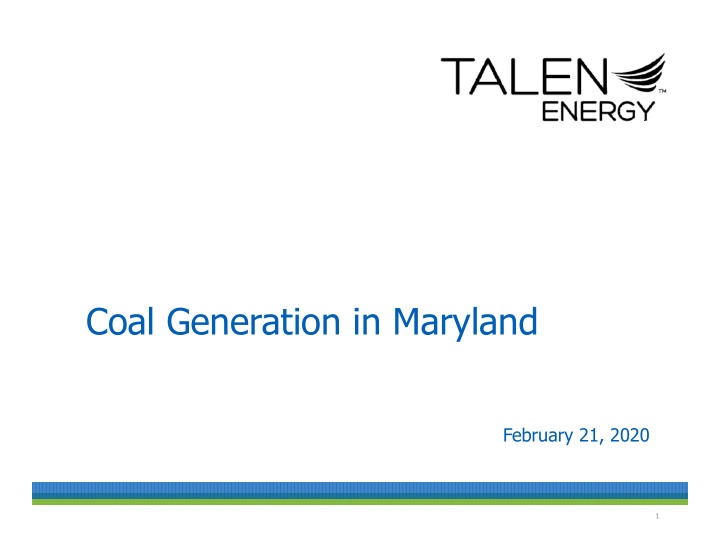



Coal Generation in Maryland February 21, 2020 1
Summary Talen’s Position Background Key Benefits Environmental Controls The Future 2
Talen’s Position Coal-fired generation: Serves a vital role in maintaining electricity reliability in Maryland; Supports jobs and the economy; Is well controlled and regulated; GHG policies should be market-based and allow for business to transition RGGI has a track record of helping achieve regional goals. 3
Background Electricity in Maryland is a deregulated market, meaning all generation is produced in a competitive market. Reliability is managed by PJM, the Regional Transmission Operator (RTO). All producers are independent businesses managing risks with no guarantee of revenue or survival. Plant Plan Own wner er County unty Generation C neration Capacity (MW) pacity (MW) Brandon Talen Anne Arundel • 1,270 Shores Wagner Talen Anne Arundel • 958 (423 MW coal – 118 MW retiring in June . 2020) Morgantown GenOn Charles • 1,477 (1229 MW coal) Chalk Point GenOn Prince Georges • 2,279 (667 MW coal) Dickerson GenOn Montgomery • 84 (537 MW coal) Warrior Run AES Washington • 180 4
Background 5
Background Approximately half of Maryland’s electricity is provided by out-of- state sources (15% of Economy-wide CO2 produced in-state). Maryland’s In-state Generation Profile: 2018 MD Generation (%) Coal 23 Natural Gas 32 Nuclear 34 Renewables 11 source: EIA 2019 MD Profile Prior to 2012 > 50% of in-state generation came from coal. 6
Background Coal-fired generation CO2 Emissions have dropped significantly since the 2006 baseline year. Reductions far exceed the economy-wide goal. Forced reductions will likely drive further increases in imported power. CO2e (MMt/yr) 2006 2017 % change Electricity Consumption 42.5 23.7 -44% In-State Generation 32.2 11.7 -64% In-state Coal Gen. 28.3 8.8 -69% Imported Electricity 10.3 12 17% source: MD GGRA Draft Report 7
Talen’s Coal plants – Key Benefits Maryland coal plants are an insurance policy for blackouts; They are projected to run very little, but provide critical capacity. The BGE transmission zone (Baltimore region) within PJM is considered “constrained” (limited import capacity) In the 2018 PJM Base Residual Capacity Auction for delivery years 2021/2022, Brandon Shores and H.A. Wagner represented approximately 80% of the available generation within the BGE zone. Although they may be infrequent, reliability events occur where Brandon Shores and Wagner have been able to generate power to avoid brown/blackouts (e.g., Polar Vortex and Oct. 2019 event). Brandon Shores and Wagner employ ~260 people directly. There are countless indirect jobs paid for by the $50M/year O&M budget. There are up to 500 labor contractors on site for annual major maintenance projects. Talen pays $7M annually in State and local taxes. 8
Emissions Controls Talen has invested close to $1B in environmental controls since 2010. Brandon Shores and Wagner together are some of the cleanest coal fired generation with average emission reductions since 2009 of: 95% SO2; 80% NOx ; and 70 % CO2. Further reductions will take place this June (Wagner 2 will retire for NOx RACT) and in January 2021, new SO2 limits will be implemented across all units. 9
The Future Between market forces, energy efficiency standards, renewable development and RGGI, generation (and associated CO2 emissions) from these plants continues to drop. Plants have not run in 2020. RGGI is and can continue to be an effective market-based mechanism for driving CO2 emissions lower. Emissions from RGGI sources have dropped by 57 % since the baseline period of 2006-2008. Allowances auctioned across all of RGGI have dropped by 67% in the same period From 2021 to 2030, available allowances will drop 2.3% per year further. In order to achieve a reduction in global CO2 emissions, it is more appropriate to utilize economy-wide policies and market-based approaches to maintain grid reliability and a thriving Maryland economy. 10
Recommend
More recommend